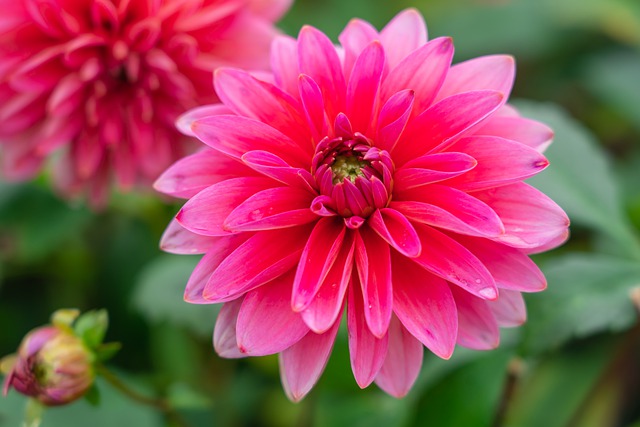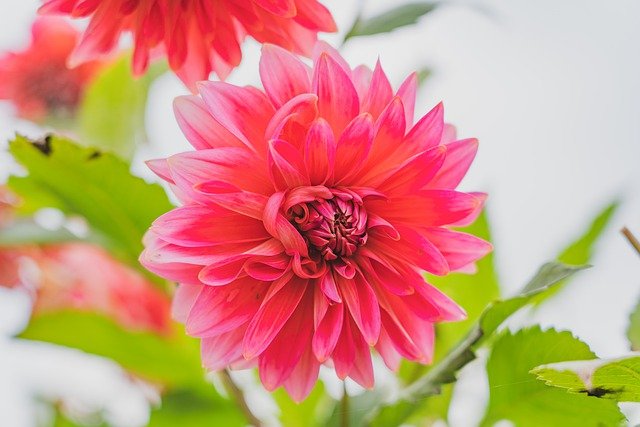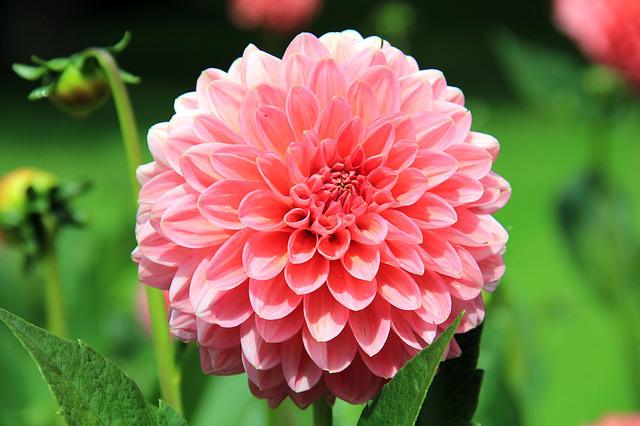Can Dahlia Grow in Pots? Growing and Caring Dahlia in Pots

Dahlias can grow in pots, but they must be filled with a good soil mixture and topped off with fresh compost every few months. Dahlias are affectionate plants that appreciate regular water and fertilizer, so make sure to give them what they need. They also require temperatures between 55-75°F (13-24°C) during the day and around 40-45°F (4-7°C) at night. Are you more curious about how to grow and care for dahlia in pots? Keep on reading!
Table of Contents
Tips Before Planting Dahlia in Pots
Choose Well-Draining Pot
Use a pot about 30cm wide and 30cm deep, and fill it with good compost. And don’t forget to cut off the tips, feed, water, cut the stems, and remove the dead flowers. A good one is about twice as big. Some dahlia stems are very long, so they need a tall pot. Make sure that the top of the tuber, where the shoots are, will sit at or above the soil level, not below.
Select the Right Varieties
Dahlias are not a plant that works for everyone. Some dahlias look like tiny pom-poms, while others are so big that they are called “dinnerplate dahlias.” Dahlias are usually divided into small, medium, and large types to make it easier to tell them apart. Dwarf dahlia varieties are ideal for container cultivation like ‘Happy Single Romeo,’ ‘Impression Festivo,’ ‘The Park Princess,’ and ‘Pulp Fiction’ Jan van Schaffelaar.’
Large dahlias can grow up to four feet tall and usually grow in the back of garden beds. Medium dahlias are about half that size and grow to about one or two feet tall. Lastly, small dahlias are small plants that grow no taller than about 20 inches.
Most of the time, it’s harder to choose the right plant for your needs (and wants) than to take care of it. But when you plant in containers, you don’t have to worry about this.
Large dahlias can grow in pots if they are big enough, but because of their size and shape, they are not good container plants. If you want to grow dahlias in a pot, it’s best to choose one of the medium-sized or small varieties that can grow well in a pot.
Plant dahlia tubers in containers to get a head start on the growing season before planting them in the ground later in the spring.
To use them in your container gardening plans, you can plant the smaller varieties of dahlia tubers outside after the frosts have passed.
Do You Need to Soak Dahlia Twigs Before Planting Them?
Dahlia tubers don’t need to be soaked before planting, as they can be planted immediately. It is possible to speed up the growth of seedlings by soaking them in water.
If you soak your dahlia tubers before starting them in pots, they’ll be ready for blooming sooner. Rehydrate tubers by soaking them for an hour in a bucket of lukewarm water before planting.
She suggests an initial soak and watering after planting to avoid overwatering the plants. Before re-watering, allow the soil to dry out to almost dry out. If the soil is too wet before the roots and top growth get a strong start, the tubers will not dry out but may decompose.

Planting Dahlias in Pots
You’ll need:
- Dahlias that are clean
- A pot for each tuber, if you have two and 3-liter pots (washed and cleaned)
- Scissors, a hand fork, a trowel, gloves, labels, and a watering can all be used for composting.
- Someplace frost-proof to put your dahlia pots
- Method for getting rid of slugs and snails
Instructions:
- Ensure your tuber is clean by cutting off any long, hairy roots with scissors. Be careful not to hurt any shoots that come up.
- Hold the tuber in the pot and fill it carefully with compost, and pack it gently around the tuber. Add water, label it, and put it somewhere that won’t freeze.
- As the tubers get bigger, shoots will come up from them. The best thing to do seems to be to let no more than five shoots grow from a tuber if you want strong, happy tubers that bloom well. First, cut off any shoots that are too long, and then do the rest. As the strong shoots that are left grow, I like to cut off the tops of the new stems with a knife or snips when there are two or three sets of leaves. This makes the stems more likely to flower.
- Check for slugs and snails often, and get rid of them if you can. They can cause a lot of damage to plants that are still young.
- When there is no chance of frost, you can plant in your borders or containers.
Caring Dahlias That Are Grown in Pots
Dahlias in full bloom look great in pots, and you should do it even if you don’t have a garden, though you’ll have to water them more often.
Sunlight
These plants need at least six hours of sunlight a day, so put them in a sunny spot in the garden. Make sure they are safe from the wind. If you give them a lot of sun, they will bloom in beautiful ways. But keep them out of the wind because the stems can break when it’s windy.
Climate
Dahlias like it warm, but they can grow outside in any climate. Tubers should only be planted where it gets cold after the last frost.
Soil
Dahlias do best in moist, rich, and well-drained soil that gets full sun in the morning and shade in the afternoon. They also need to be protected from the wind. Before planting, improve the soil by digging in well-rotted organic matter like compost, leaf mold, or manure. You should stake them when you plant tall growers, so you don’t hurt the tuber. They do well in both cool and warm, moist places. If the soil doesn’t drain well, plant in a raised bed or a pot.
Water
When you plant in the spring, water a lot first and then less until the plant is about 15 cm tall.
After planting tubers, don’t water them until the leaves are about 15 cm tall. If the soil is dry, you could end up with rotting tubers. Also, if you have very wet winters, dig up the tubers, or they will rot. Once the plant is set up about twice a week, water it.
The watering schedule for your dahlia plant should be altered now that the stem has surpassed the pot’s rim and there is considerable foliage.
At least two or three times per week, you must water your plants. Regular watering is required if you cultivate the plants in a hotter climate.
As long as the container has sufficient drainage, there is no need to worry about the soil becoming waterlogged. Nevertheless, you must verify it. If the soil occasionally becomes waterlogged, you should cease watering it daily.
Fertilizer
When the plants are about 30cm tall, use a fertilizer that can be used for many different things. Spread it around the plant in a circle, dig it in with a fork and give it a lot of water. When the buds show up, give the plant a liquid feed of soluble fertilizer every 10 to 14 days to help it grow big blooms that last longer. Organic mulch and regular watering protect the soil from the hot summer sun.
In the spring, use a fertilizer with little nitrogen. Too much nitrogen makes the plant grow leaves instead of flowers. And that’s why they’re grown in the first place!
Pruning
As dahlias grow, pinch off the growing tips to make them grow sideways and make a bushier plant. Cut flowers often to encourage them to bloom. They make great cut flowers to put in vases. Flowering lasts 3-5 months. Cut the bush back by half when the flowers die off in late fall. When the leaves die off, cut the bush down to the ground.
Attaching the Stump to the Stalk
As soon as the stalk reaches one foot in height, it should be tied to the stake. Standard cable ties are useful, though they must not be overly tight.
In this regard, nylon or even twine strings are a good option. For it to remain in place, it must be tied every foot. Just make sure that you don’t tie it up too tightly.
Overwintering Dahlias in Pots
Dahlias can also be left in pots all winter. If you want to try this method, leave them outside until the frost kills the leaves.
They will sleep if you leave them outside when the weather gets cooler in the fall. Once the leaves have died, cut them back to the soil, and bring the pot inside before it gets too cold.
If a hard freeze is coming, move the container to a garage or shed that isn’t heated to keep it safe. The goal is to keep the pot cool enough so that the plant goes to sleep before being brought inside but not so cool that the bulbs freeze.

